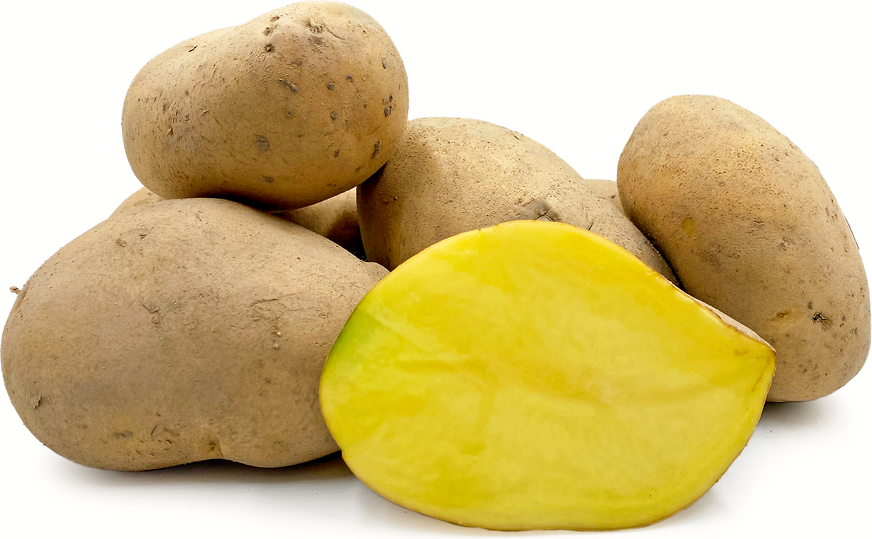


Blue-Eye Potatoes
Estimated Inventory, lb : 0
Description/Taste
Blue-Eye potatoes are generally medium to large tubers with an oval to oblong shape, but each tuber may vary in size and shape depending on growing conditions. The skin is semi-smooth, thin, ranges in color from beige to brown, and may be covered in flakes and some dark brown specs and spots. The tubers also have a few uniquely colored, purple-blue eyes. Underneath the surface, the flesh is ivory to golden and is dense, firm, and finely-textured. When cooked, Blue-Eye potatoes have a tender, flaky consistency and a mild, neutral, and earthy flavor.
Seasons/Availability
Blue-Eye potatoes are available year-round, with a peak harvest season in the late summer through early fall.
Current Facts
Blue-Eye potatoes, botanically classified as Solanum tuberosum, are uniquely-colored, hybrid tubers that belong to the Solanaceae or nightshade family. Also known as Sineglazka potatoes, Blue-Eye potatoes are a mid-season variety that was developed at the Institute of Starch Products in the 1940s and was created through multiple crosses between wild and cultivated potato varieties. Blue-Eye potatoes are not commercially produced due to their short shelf life and are considered to be somewhat rare, primarily localized to home gardens and small, specialty farms.
Nutritional Value
Blue-Eye potatoes are an excellent source of vitamin C, which is an antioxidant that can help boost the immune system and rebuild collagen within the body. The tubers also contain vitamin B6, dietary fiber, and potassium.
Applications
Blue-Eye potatoes are best suited for cooked applications such as baking, roasting, frying, boiling, and mashing. The tubers have a versatile texture that allows them to be suitable for a wide variety of recipes, and they can be sliced and added to salads, cooked into French fries, boiled and mashed, or diced and tossed into soups, stews, casseroles, and chowders. The tubers can also be baked or roasted as a side dish, cubed and nestled under roasts, or shredded and fried into fritters. In addition to main dishes, Blue-Eye potatoes also have a smooth texture when cooked and pureed and are commonly used in baby food. Blue-Eye potatoes pair well with green onions, dill, carrots, peas, eggs, meats such as poultry, pork, beef, and lamb, mushrooms, Dijon mustard, and cheeses such as cheddar, parmesan, and asiago. The fresh potatoes should be used immediately for the best flavor as they have a short shelf life and will keep for 2-5 weeks when stored in a cool, dry, and dark place.
Ethnic/Cultural Info
In Russia, Blue-Eye potatoes were targeted specifically for home garden cultivation and were favored for their unusual blue-purple eyes, ability to withstand cold climates, productive nature, and resistance to many diseases. The variety was even handed out freely in the city of Smolensk to encourage residents to cultivate the tubers. With the variety’s ease of cultivation, its popularity quickly increased across Russia and became one of the most widely used cultivars in everyday cooking. Potatoes such as Blue-Eye are also used in traditional holiday recipes such as Olivier or Russian salads. Commonly consumed on New Year’s Eve in Russia, the potato salad is made from a mixture of boiled meat, eggs, potatoes, carrots, pickles, and peas. Though many variations of the recipe exist among home chefs and restaurants, the original salad recipe dates back to the 1800s.
Geography/History
Blue-Eye potatoes were created at the Institute of Starch Products in 1940 by potato breeder S. Denim. The tuber was created from multiple crosses between wild and cultivated species to obtain its signature, colored eyes, and though the potato has a short shelf life, it has remained a favorite variety among small farms and home gardens. Today Blue-Eye potatoes are found through farmer’s markets in Eastern Europe and Central Asia. The potatoes in the photo above were discovered at the Green Market in Almaty, Kazakhstan.











